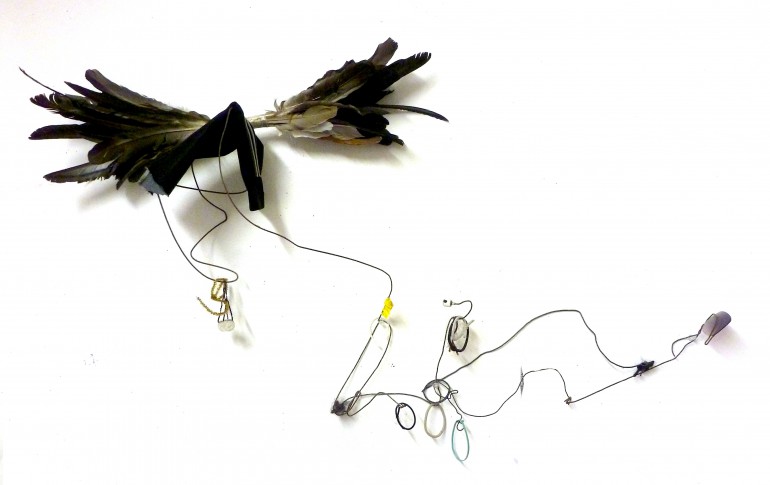William Cordova’s solo exhibition wayar mallku: metafisica de espacio y tiempo, January 21 – February 22, at 80M2 / Livia Benavides, Lima, Peru.
“Space, like language, is socially constructed; and like the syntax of language. the spatial arrangements of our buildings and communities reflect and reinforce the nature of gender, race and class relations in society. The uses of both language and space contribute to the power of some groups over others and the maintenance of human inequality”
– Leslie Kanes Weisman
yawar mallku: metaphysics of space and time is a project that investigates the fundamental properties of being, temporality and alchemy.
This project incorporates sculpture as a way to make visible the invisible, to frame the unframed presence of marginalized subjects, history, language and landscape. One piece, this one’s 4U (pa’ nosotros), a wooden scaffolding turned sideways to symbolize abrupt change, construction and alternative function. It incorporates a video projector and a large white sheet that relate to concepts of 3rd Cinema coined by Argentine filmmakers Fernando Solanas and Octavio Getino in 1969. 3rd Cinema is the urgency to reject Hollywood film values in order to create, discuss and invent example that reflect a true representation of the quotidian life.
4th Cinema then is the result of creating a temporary space for the 3rd Cinema manifesto. A scaffolding turned sideways with video projector mounted atop projecting into a make shift screen. The act of transforming is what the sculpture this one’s 4U (pa’ nosotros) is about. It includes the simultaneous screening of Tupac Shakur: Thug Angel, the Life of an Outlaw (2002) by Peter Spirer and Tupac Amaru (1985) by Federico Garcia. Garcia’s Tupac Amaru is a cinematic narrative of the Andean leaders indigenous and African slave led uprising in Peru against Spanish rule in 1780. Tupac by Peter Spirer documents the life and times of the often misunderstood activist and Rap artist Tupac Amaru Shakur who was named after the Andean Tupac Amaru. It can be said that both the 18th and 20th Century Tupac’s have had a controversial history. Both are individually celebrated for their self-determination and symbolic influence in Latin America, the Caribbean and North America and yet both share a lack of social awareness towards their of parallel struggles and influences. Furthermore, the Peruvian Tupac Amaru film is not even available commercially.
“a slow construction of my self as a body in a spatial and temporal world seems to be the schema. It is not imposed on me; it is rather a definitive structuring of my self and the world”
– Frantz Fanon (Black Skin/White Masks)
Cordova’s feature length film projection, dwellings (sculpting elsewhere in time or Halim El-Dabh), is a “collections of narrative bits joined together by poetic associations of various images and events in such a way that their progression provides space for metaphoric meaning which emerges between the sequences and juxtaposed shots.”1 This sculpture/film prompts the viewer to reconsider their role as spectator and provokes them to construct a narrative from 2 separate 35MM film slide projections and audio (custom LP vinyl recording). The piece includes an image of a building in Dusseldorf, Germany where electronic music band pioneers Kraftwerks were based (1970-2009) next to an image of a building in Miami, Florida where Bass Station Records (1986-1988) once stood. Bass Station pioneered early Southern Hip-Hop, “Booty Bass Music,” mixing English/Spanish language and music genres. Bass Station was also one of the first to sample Kraftwerks music in large capacity in early Southern Rap music and re-introducing the German electronic group to a new generation.
What many are unaware of is that electronic music sampling and looping started with Halim El-Dabh’s composition The Expression of Zaar (1944). El-Dabh, an Egyptian student studying agricultural engineering and music in Cairo sampled and looped an audio piece that is today considered to be the first ever sound manipulation with a wire audio recorder a predecessor for contemporary audio recorders until the digital revolution.
The 35MM projector functions as a sculpture, monument, and vessel. The images projected display two different landscapes, geography, economy, architecture and time. A visual map of sorts like the Gold LP on the Voyager space craft.
“Each projection of a film act presupposes a different setting, since the space where it takes place, the materials that go to make it up and the historic time in which it takes place are never the same. This means that the result of each projection act will depend on those who organize it, on those who participate in it.”
-Fernando Solanas and Octavio Getino (Towards Third Cinema)
The conclusion of this project is to create a space for public contemplation. One that debunks the linear for the plural. Proposing alternative pasts thus changing our perception of history, people and landscape.
-william cordova
1.Coleman A. Jordan (Autobio-graphic Space)
